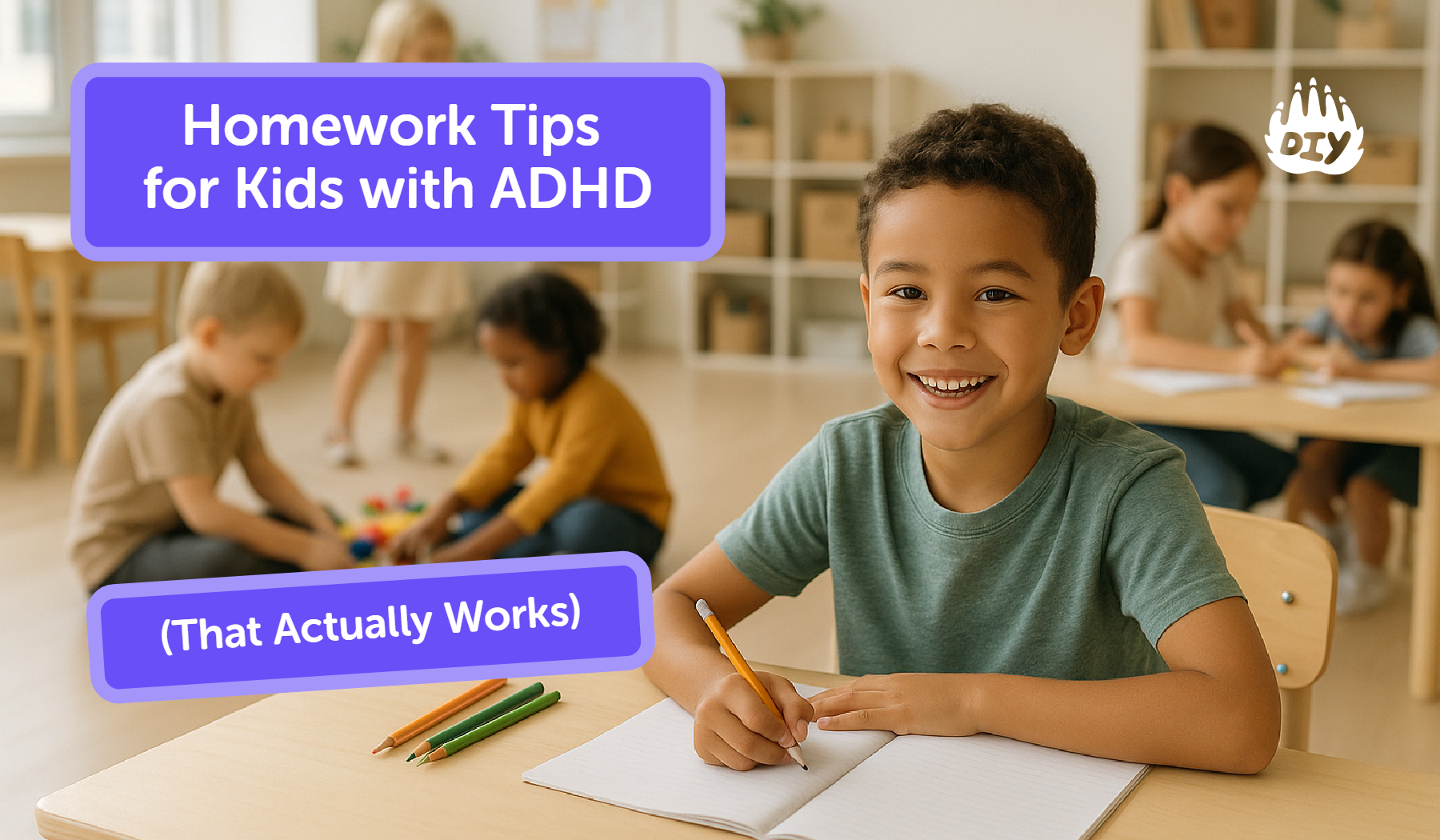Homework can feel bigger than it is when attention, time perception, and working memory make every step harder. The good news: small, predictable routines help kids with ADHD start faster and finish with fewer battles. Use the ideas below to build a calm after‑school plan and a short, visual checklist.
Need a one-click plan for tonight? Try DIY.org’s AI Homework Helper to turn assignments into a kid-friendly checklist.
Snack and water, then 10–15 minutes of movement.
Pick a start time and set a visual timer.
Break work into mini‑tasks (2–10 minutes each).
Clear the desk to one page or one problem.
Use a visual checklist and a small reward at the end.
Build the After‑School Routine
Routines reduce decision fatigue. Start with a decompress block (snack, movement, or outdoor time), then a predictable homework window. Offer choice within structure: let your child pick subject order or timer length. Anchor the habit with the same study spot, the same soundtrack, and a filled water bottle.
Set Up an ADHD‑Friendly Homework Space
A few small tweaks make focus easier:
Area | What to Do |
|---|---|
Low-clutter, high-signal | Keep only the current task on the desk; move everything else to a “not now” bin. |
Noise plan | Use headphones with brown noise, or work in a quiet corner away from foot traffic. |
Sensory supports | Add a wobble cushion, a resistance band on chair legs, and a silent fidget. |
Lighting & posture | Use a bright task light; keep feet grounded on a box or stool if needed. |
Make Work Manageable: Break, Time, and Track
Chunk big tasks into micro‑goals. Instead of 'do the worksheet,' try four groups of three problems. Run gentle timer cycles like 10 minutes on, 5 off. Sit nearby and do your own quiet task; this is body doubling. Show progress with checkboxes, a highlighter path, and a simple 'done' tray.
Open the Homework Helper and ask it to split a worksheet into 4 mini-tasks with timers.
Motivation Without Battles
Start easy to win early: pick a quick task first.
Use tiny rewards: a 5‑minute choice break or one small token.
Gamify the boring: beat the timer, collect streaks for on‑time starts.
Praise the process: effort, strategies, and start‑ups matter more than speed.
Planner Systems That Stick
Keep one planner and one method daily card or week‑at‑a‑glance. Color‑code subjects and match colors between school and home. Do a short Sunday reset to add tests, projects, and practices. For younger kids, pictures beat walls of text: use icons for reading, math, and pack‑up.
Team Up With Teachers: IEP & 504 Homework Supports
Ask for clarity: one‑page directions and a worked example.
Right‑size the load: reduced items, alternate tasks, or extended time when appropriate.
Where work happens: quiet space, small group, or split sessions across class and home.
Keep a communication loop: a weekly check‑in and a simple home–school checklist.
Tools and Apps Kids Actually Use
Tool / App Type | What to Use | Why It Helps |
|---|---|---|
Timers | Visual timers or simple countdown apps kids can start on their own | Makes time concrete and reduces nagging; supports short work–break cycles |
Checklists | To-do apps with large check boxes and a daily reset | Keeps tasks visible and doable; easy wins from checking off steps |
Reading help | Text-to-speech tools and page rulers | Lowers visual load and supports sustained reading focus |
Math helpers | Scratch paper template and graph/ruled paper | Keeps work neat and organized; easier to line up numbers and show steps |
Launch the AI Homework Helper for kid-safe hints, worked examples, and printable checklists.
Troubleshooting Common Roadblocks
“I’ll do it later.” → Set a 2‑minute start and sit nearby (body doubling).
Meltdowns mid‑task → Pause, drink water, then a short movement break.
Perfection stalls → Do a messy first pass, then fix one thing after.
Evenings packed → Try a morning sprint, a weekend block, or a shortened set with teacher approval.
Meds wear off → Front‑load tougher work earlier in the day; talk with the care team about timing.
Always consult your child’s clinician or school team for individual needs.
Sample 30‑Minute Plan (printable)
0–5: set up, fill the checklist, and pick task order.
5–15: Task 1 (timer on), check it off when done.
15–20: break (movement + water).
20–28: Task 2 (timer on), mark progress.
28–30: pack backpack, reward, reset the study space.
FAQs
How long should homework take for kids with ADHD?
Aim for short, focused bursts with breaks. Many families do best with two 10‑minute work cycles and a short wrap‑up. Teachers can help adjust load and timing.
What’s the best time to start homework after school?
Most kids focus better after a 20–30 minute decompression window. Pick a consistent start time and use a visual timer.
What if my child refuses to start?
Shrink the first step to two minutes, sit nearby, and praise the start. If refusal is frequent, ask the teacher about right‑sizing the work.
Does fidgeting help or hurt focus?
Silent, low‑distraction fidgets and chair bands can help the body move while the brain works. Test one tool at a time.
What is body doubling and how do we try it at home?
Body doubling means working alongside someone else. Sit nearby, do your own quiet task, and keep prompts brief.
How do I ask for reduced homework or alternatives?
Bring examples of how long tasks take at home. Request specific support in an IEP or 504 meeting, like reduced items or alternate formats.
Are timers helpful or stressful for ADHD?
Timers help when they are visible and predictable. Keep intervals short and pair them with choice breaks.
How can we handle homework when activities run late?
Use a morning mini‑session, weekend block, or split tasks across days. Coordinate with teachers for flexibility when needed.


